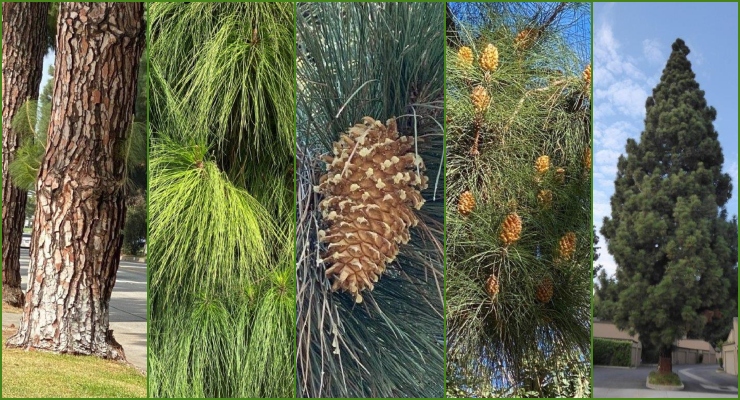
Each month, Pasadena Beautiful Tree Program Chair Emina Darakjy presents a ‘tree of the month’ in order to educate Pasadenans about the trees around them. Many people drive by trees they admire, but have no idea what they are called, or what their growing habits are. Pasadena Beautiful was founded in 1960 by a group of volunteers who saw a need to beautify their city and enhance its tree canopy.
The Canary Island pine is a member of the Pinaceae family and is native to Spain’s Canary Islands in the Atlantic Ocean off the coast of Morocco.
This is a large evergreen conifer. It is fast growing, and can reach a height of more than 80 feet with a spread of 25 to 40 feet.
Like so many of us, when young, this tree looks very gawky, developing a conical crown as it gets older. Its branches are covered with blue-green soft needles that turn dark green with age. In the Canary Islands where this tree is from, the soft needles are often used as packing material for shipping bananas.
The trunk of the Canary Island Pine is very attractive with a reddish-brown and fissured bark. The bark is very durable, and as the tree grows older, more layers of bark form, making the tree resistant to wildfires. The tree can also easily re-sprout after being burned, and is valued for the quality of its wood, which is used in construction and furniture-making.
The tree produces five to seven inch-long oval cones that are green at first, then turn glossy brown with age. The cones take about two years to mature. After two years the cones open up, releasing pine nut seeds that are a good source of food for many small animals such as squirrels.
The Canary Island pine requires a parkway width of 10 feet, and the damage to sidewalks from its roots is moderate. It performs better in a sunny location and requires very low maintenance. It can tolerate almost any type of soil with good drainage and is drought tolerant. In fact, applying too much water can kill the tree.
The Canary Island pine is also susceptible to beetle borers and aphids but is resistant to Oak root fungus.
The tree is an excellent choice for planting in yards, parks and as a street tree. Some cities, like Whittier and Beverly Hills, have streets that are completely lined with Canary Island pines.
When driving along Beverly Boulevard in Whittier, which has about 200 Canary Island pines growing on it, one can’t help being awed by these tall and majestic trees.







